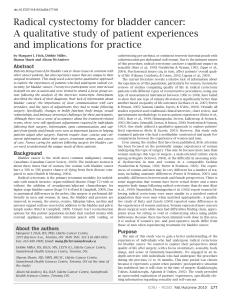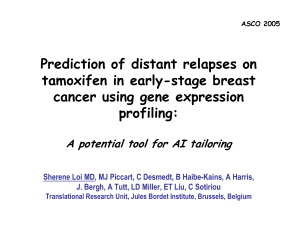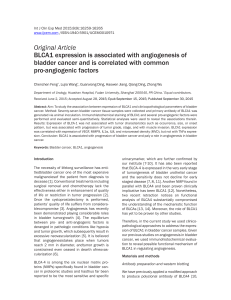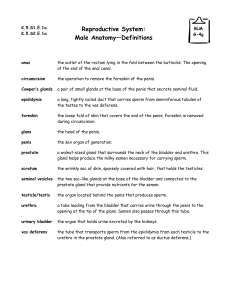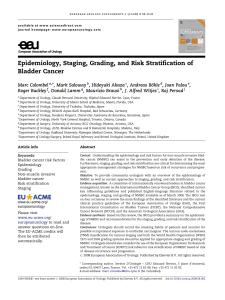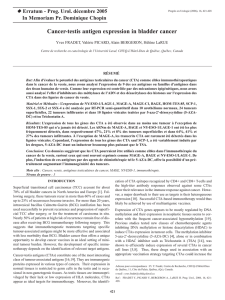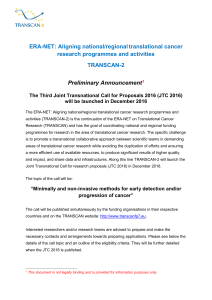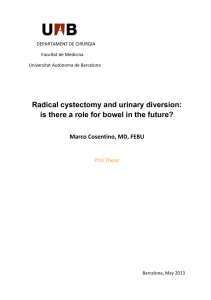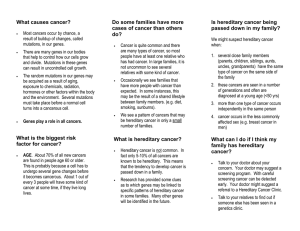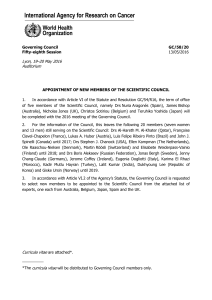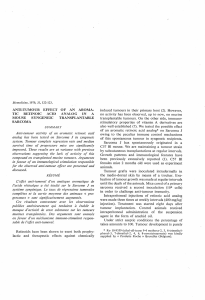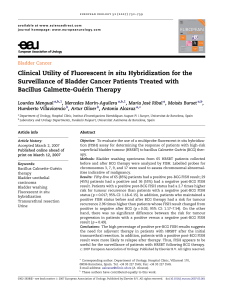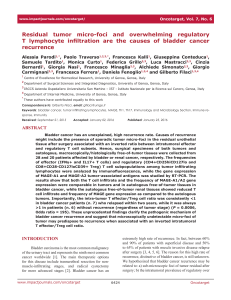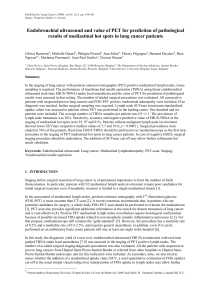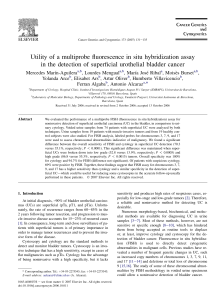05.MMA_Resultados_4.pdf
publicité
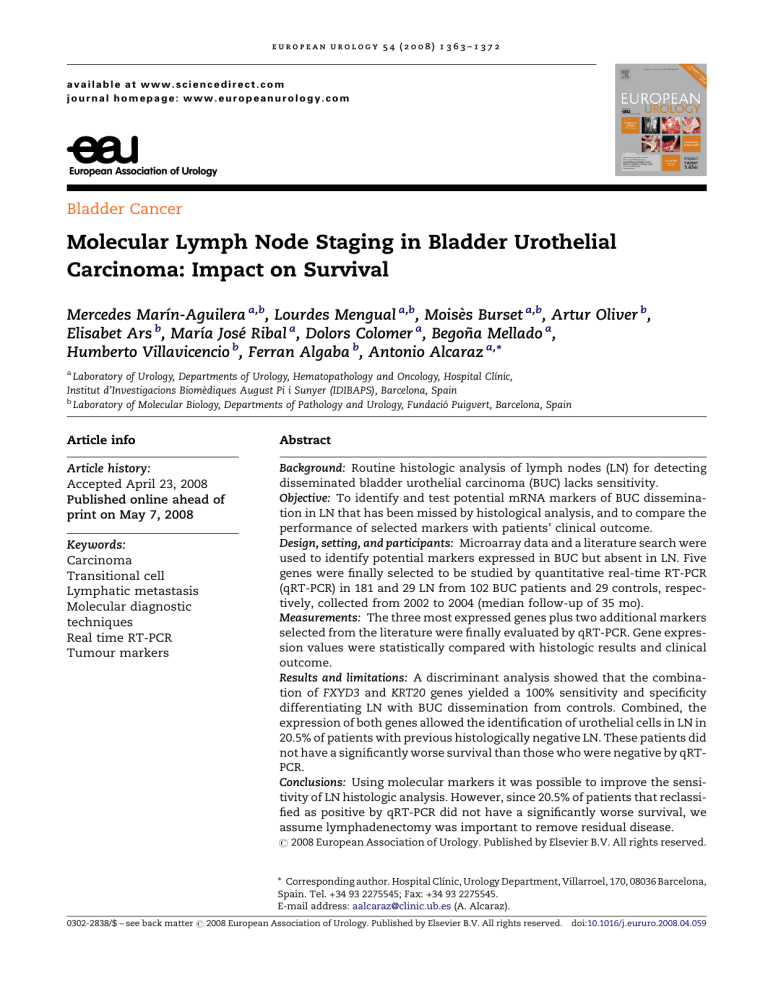
european urology 54 (2008) 1363–1372 available at www.sciencedirect.com journal homepage: www.europeanurology.com Bladder Cancer Molecular Lymph Node Staging in Bladder Urothelial Carcinoma: Impact on Survival Mercedes Marı́n-Aguilera a,b, Lourdes Mengual a,b, Moisès Burset a,b, Artur Oliver b, Elisabet Ars b, Marı́a José Ribal a, Dolors Colomer a, Begoña Mellado a, Humberto Villavicencio b, Ferran Algaba b, Antonio Alcaraz a,* a Laboratory of Urology, Departments of Urology, Hematopathology and Oncology, Hospital Clı́nic, Institut d’Investigacions Biomèdiques August Pi i Sunyer (IDIBAPS), Barcelona, Spain b Laboratory of Molecular Biology, Departments of Pathology and Urology, Fundació Puigvert, Barcelona, Spain Article info Abstract Article history: Accepted April 23, 2008 Published online ahead of print on May 7, 2008 Background: Routine histologic analysis of lymph nodes (LN) for detecting disseminated bladder urothelial carcinoma (BUC) lacks sensitivity. Objective: To identify and test potential mRNA markers of BUC dissemination in LN that has been missed by histological analysis, and to compare the performance of selected markers with patients’ clinical outcome. Design, setting, and participants: Microarray data and a literature search were used to identify potential markers expressed in BUC but absent in LN. Five genes were finally selected to be studied by quantitative real-time RT-PCR (qRT-PCR) in 181 and 29 LN from 102 BUC patients and 29 controls, respectively, collected from 2002 to 2004 (median follow-up of 35 mo). Measurements: The three most expressed genes plus two additional markers selected from the literature were finally evaluated by qRT-PCR. Gene expression values were statistically compared with histologic results and clinical outcome. Results and limitations: A discriminant analysis showed that the combination of FXYD3 and KRT20 genes yielded a 100% sensitivity and specificity differentiating LN with BUC dissemination from controls. Combined, the expression of both genes allowed the identification of urothelial cells in LN in 20.5% of patients with previous histologically negative LN. These patients did not have a significantly worse survival than those who were negative by qRTPCR. Conclusions: Using molecular markers it was possible to improve the sensitivity of LN histologic analysis. However, since 20.5% of patients that reclassified as positive by qRT-PCR did not have a significantly worse survival, we assume lymphadenectomy was important to remove residual disease. Keywords: Carcinoma Transitional cell Lymphatic metastasis Molecular diagnostic techniques Real time RT-PCR Tumour markers # 2008 European Association of Urology. Published by Elsevier B.V. All rights reserved. * Corresponding author. Hospital Clı́nic, Urology Department, Villarroel, 170, 08036 Barcelona, Spain. Tel. +34 93 2275545; Fax: +34 93 2275545. E-mail address: [email protected] (A. Alcaraz). 0302-2838/$ – see back matter # 2008 European Association of Urology. Published by Elsevier B.V. All rights reserved. doi:10.1016/j.eururo.2008.04.059 1364 1. european urology 54 (2008) 1363–1372 Introduction The presence of tumour cells in lymph nodes (LN) at the time of cystectomy is a major prognostic factor in patients with muscle-invasive bladder urothelial carcinoma (BUC) [1]. Lymphadenectomy complementing this radical surgery is an essential tool that not only provides staging of the tumour but also therapeutic benefits. Currently, this staging is usually limited to routine pathological evaluation of hematoxylin-eosin (HE)-stained sections of regional LN. Unfortunately, this technique occasionally misses small cancer foci which are thought to be histologically undetectable micrometastasis in the regional LN. Whatever it may be, around 50% of patients with pT3-4 tumours but histologically node negative disease die within 5 yr of radical cystectomy [2]. A molecular technique such as reverse-transcription PCR (RT-PCR) has been applied in various solid tumours to determine the presence of missed tumour cells in LN during routine pathologic examination [3–5]. However, quantitative real-time RT-PCR (qRT-PCR) has been proven to be more efficient than conventional RT-PCR in the detection of rare events [6]. To develop an efficient approach for detecting disseminated tumour cells, not only is a highly sensitive technique such as qRT-PCR needed but also suitable markers. In this respect, a highthroughput technique such as DNA microarrays allows the study of gene expression profiles in different tissues providing a rich source of information. In this study, DNA microarrays were used for identifying genes specifically expressed in bladder which could indicate BUC dissemination in LN. Detection of selected markers in LN by qRT-PCR was correlated with histologic findings and patients’ clinical outcome. 2. Material and methods 2.1. Molecular markers selection To determine a panel of highly specific mRNA markers of BUC dissemination in LN, gene expression from bladder tissue (normal and tumour) and blood were compared. Specifically, public data from U133A Affymetrix GeneChip (Affymetrix, Santa Clara, CA, USA), hybridized with RNA from 16 blood samples (http://www.ncbi.nlm.nih.gov/geo/; GEO accession code GSE1343) were compared with data obtained from our group (GSE7476) using U133 plus 2.0 Affymetrix GeneChip, hybridized with 3 normal and 9 tumoral urothelium pools from 55 RNA samples. In order to select genes that were overexpressed in the urothelium but minimally or unexpressed in blood, a set of maximum expression cutoffs for intensity values (arbitrary units) in blood samples (50, 100, 150) was empirically established, as well as a set of minimum cutoffs in urothelial tissues (3000, 2000, 1000). Those four genes with the highest mean expression value in both normal and tumour urothelial cells but with low expression in blood were selected for evaluation by qRT-PCR. In addition, the expressions of two conventional markers for epithelial cells that have been widely tested as BUC dissemination markers in the bibliography [7–10] were also studied. The selected candidate genes (see Results) were tested in a population of 102 patients described below (section 2.2.1). 2.2. Candidate marker genes validation 2.2.1. Subjects and samples of study A total of 181 right and left lymph node specimens, from 102 BUC patients (10 women and 92 men; average 66 yr; range 42– 85) who underwent radical cystectomy and pelvic lymphadenectomy between August 2002 and July 2004 were included in this study. Lymphadenectomy in our institution consists of removing the obturator, internal, external, and common iliac nodes. As controls, 29 lymph node samples from 29 patients who were recipients for kidney transplantation (5 women and 24 men; average 41 yr; range 18–61), without any evidence of having malignant diseases were analyzed. The time to recurrence was the interval from cystectomy to the confirmation of the metastases. In patients who did not have metastases, follow-up was recorded as the number of months from the cystectomy to the last patient observation. In patients with metastases or death, follow-up was recorded until the date of the event. The hospital ethics committee approved this study and the patients and controls provided their informed consent before participating in the study. Tissue sections of right and left nodes (if available) from each patient were immediately frozen after collection in liquid nitrogen and were subsequently stored at 80 8C until RNA extraction. The remnants were stained with HE for routine pathological examinations [11]. According to the pathological results (Table 1), LN were classified into three groups: histologically positive [N(+)], histologically negative [N( )], and controls from patients with nonneoplasic disease. To test the ability of selected genes as markers of tumour dissemina- Table 1 – Pathological stage and node status of BUC patients at time of cystectomy Patholgical stage* pN0* All patients pN1–3* n % n % n pT0 pTis pTa pT1 pT2 pT3 pT4 23 6 5 12 17 23 16 22.5 5.9 4.9 11.8 16.7 22.5 15.7 21 6 4 11 12 18 11 20.6 5.9 3.9 10.8 11.8 17.6 10.8 2 – 1 1 5 5 5 2 – 1 1 4.9 4.9 4.9 Total 102 83 81.4 19 18.6 100 BUC = bladder urothelial carcinoma. According to International Union Against Cancer 2002 [30]. * % european urology 54 (2008) 1363–1372 tion, these samples were divided in two sets: the training set, which included N(+) and controls samples, and the validation set, which comprised N( ) samples. 2.2.2. Quantitative real-time PCR analysis Total RNA was extracted using the Trizol Reagent (Invitrogen Life Technologies, Carlsbad, CA, USA) according to the manufacturer’s instructions. Two mg of total RNA were reverse-transcribed with a random hexamer primer mix in a 20 ml reaction mix using SuperScriptII Reverse Transcriptase (Invitrogen Life Technologies, Carlsbad, CA, USA) according to the manufacturer’s instructions. Gene expression quantification of the selected genes was performed in the 181 LN biopsies using TaqMan Gene Expression Assays and an ABI PRISM 7000 SDS (Applied Biosystems, Foster City, CA, USA) according to the manufacturer’s recommendations, except that the final volume of the reaction was 20 ml. Beta-glucuronidase gene (GUSB) was used as endogenous control. All samples were analyzed in duplicate and the Cycle threshold (Ct) mean was obtained for further calculations. Each experiment included a negative nontemplate control and an interexperiment control. The relative expression level of the marker genes for each sample was described as the difference between the average Ct from the target gene and the average Ct from GUSB. 2.2.3. 1365 selected (C10orf116, KRT19, FXYD3 and AGR2) for evaluation in the training set of samples [N(+) and controls]. Subsequently, C10orf116 was discarded as it presented similar expression levels in control and in N(+) samples. According to previous results from our group and data published by other groups [8,12], KRT20 and UPK2 were also included for testing as molecular markers for BUC dissemination. Moreover, KRT20 and UPK2 presented average expression values of 31.9 and 18.69 in blood, and 4669 and 954 in bladder, respectively, according to microarray analysis. 3.2. Candidate marker genes validation 3.2.1. Pathological analysis Paraffin-embedded slices from all 181 LN biopsies were evaluated after HE-staining. In terms of individual biopsy specimens, this pathological examination detected tumour cells in 21 samples (11.6%) [representing 19 of the 102 patients (18.6%)]. In contrast, 160 samples (88.4%) showed no sign of tumour dissemination by this technique [83 patients, (81.4%)] (Table 1). Statistical analysis The Mann-Whitney test was performed to compare gene expression values between control and N(+) samples (samples from the training set). In order to evaluate the ability of individual genes to distinguish between N(+) and control LN in the training set, a receiver operating characteristic (ROC) curve for each selected gene was constructed using the markers’ relative expression values. Finally, to obtain the combination of genes that provided the best discrimination between both sample types, a discriminant analysis was also performed using the aforementioned training set of samples. A ROC curve for the discriminant function was also constructed. The cutoffs obtained by both ROC analyses, for independent and for combined genes, were evaluated in the validation set of samples [N( )]. According to these cutoffs, samples were classified as qRT-PCR(+) and qRT-PCR( ). Recurrence-free survival and cancer-specific survival curves were calculated using the Kaplan-Meier method. SPSS v13.0 and MedCalc v8.1 softwares were used for statistical analyses. 3. Results 3.1. Molecular markers selection A list of 49 candidate marker genes specifically expressed in bladder was obtained from microarray data analysis (Table 2). The four genes with the highest expression values in urothelial tissue, together with an expression value in blood of lower than 50 in all the samples analyzed, were initially 3.2.2. Quantitative real-time PCR analysis Table 3 shows the expression values for each marker according to samples’ pathological classification. Differences between control and N(+) samples (training set) were statistically significant for the gene expression values of each marker ( p < 0.0001) (Fig. 1; Table 3). Fig. 1 – Gene expression values of the five selected mRNA markers. Relative gene expression values of five markers genes KRT20, UPK2, AGR2, FXYD3, and KRT19 in the training set [control and N(+)samples]. The median expression level for each marker gene within a group is indicated by a horizontal line. * Significant, p < 0.05. 1366 european urology 54 (2008) 1363–1372 Table 2 – Average expression values of candidate genes resulting from the comparison of microarray expression data between bladder (normal and tumour) and blood tissues Cutoff microarray expression values Gene symbol Affymetrix ID Accession number Gene expression in bladder Average Gene expression in blood Range Average Max Min Range Max Min Bladder_min>3000, Blood_max < 50 C10orf116 KRT19 203571_s_at 201650_at NM_006829 NM_002276 14059.2 12119.2 22677 15774 7360 6097 9.5 6.2 26 23 4 3 Bladder_min>2000, Blood_max<50 FXYD3 202489_s_at NM_005971 7312.5 12834 2842 20.1 46 5 209173_at 207935_s_at 209016_s_at 201427_s_at 209109_s_at 201830_s_at 201829_at 201983_s_at 207714_s_at NM_006408 NM_002274 NM_005556 NM_005410 NM_003270 NM_005863 AW263232 AW157070 NM_004353 6051.7 5644.9 5155.6 3427.7 2872.4 2426.8 1559.2 1970.6 1800.8 13122 11395 8386 7187 7949 5232 2670 3257 2628 1896 1203 1184 1236 1253 1416 993 1088 1182 8.4 16.5 7.1 18.4 15.6 8.9 44.9 12.7 17.1 18 47 24 46 31 31 83 48 35 4 4 2 4 6 2 4 6 7 214079_at 206463_s_at AK000345 NM_005794 9250.2 7580.3 14423 11865 6004 4410 38.3 24.4 98 91 3 5 215076_s_at 201852_x_at 205319_at 201131_s_at AU144167 AI813758 NM_005672 NM_004360 8793.7 7362.4 6587.1 4251.8 13961 11351 14025 6229 2586 2235 2128 2234 28.1 63.5 26.9 8.9 67 151 73 50 5 26 3 2 210495_x_at 212464_s_at 211719_x_at 216442_x_at 212282_at 212281_s_at 209071_s_at 209070_s_at 218353_at 200636_s_at 200635_s_at 200637_s_at 210946_at 209147_s_at 202310_s_at 202404_s_at 201667_at 204607_at 201286_at 217744_s_at 217975_at 201215_at 201015_s_at 201508_at 202609_at 212533_at 208820_at AF130095 X02761 BC005858 AK026737 BF038366 BF038366 AF159570 AI183997 NM_025226 NM_002840 AU145351 AI762627 AF014403 AB000888 K01228 NM_000089 NM_000165 NM_005518 Z48199 NM_022121 NM_016303 NM_005032 NM_021991 NM_021991 NM_004447 X62048 AL037339 5982.0 5948.4 5940.2 5859.7 5878.8 4158.6 5020.0 2996.3 1719.5 3018.6 1440.1 1261.5 2828.2 2472.7 5433.2 5432.8 4817.3 4505.2 3720.8 3474.6 2690.1 2529.5 2453.3 2355.5 2075.6 1715.9 1600.8 12388 12067 12183 12084 11141 8238 10346 7579 4528 4527 2207 1868 4039 3787 8725 9580 8501 11812 6683 6171 5401 4281 3919 3706 3147 2921 2405 1016 893 957 1001 1827 1169 1376 796 379 1505 606 472 927 1270 1486 1740 1376 1018 1525 1532 1401 1246 1206 1443 1177 1051 1174 30.5 29.3 8.8 44.9 74.0 37.4 22.0 22.5 38.9 26.8 29.8 17.5 45.3 31.4 20.9 20.0 18.6 28.6 34.7 40.6 58.1 24.9 22.3 27.8 44.0 33.7 22.6 80 55 20 138 133 69 85 41 95 74 61 44 117 64 85 64 56 84 67 70 93 54 68 65 77 99 77 7 9 4 9 21 8 5 9 2 4 10 6 6 5 6 4 1 4 7 7 17 4 10 12 5 3 3 206239_s_at 201596_x_at 208937_s_at NM_003122 NM_000224 D13889 17957.2 11845.5 10663.2 30345 22160 15171 7522 4653 5456 64.4 69.1 52.3 150 143 111 16 29 4 Bladder_min>1000, Blood_max<50 AGR2 KRT13 KRT7 SEPP1 TM4SF6 NET1 EGFR SERPINH1 Bladder_min>3000, Blood_max<100 DHRS2 Bladder_min>2000, Blood_max<100 COL3A1 PSCA CDH1 Bladder_min>1000, Blood_max<100 FN1 MAC30 RGS5 PTPRF PPAP2A COL1A1 COL1A2 GJA1 HMGCS2 SDC1 PERP LOC51186 PLS3 JUP IGFBP4 EPS8 WEE1 PTK2 Bladder_min>3000, Blood_max<150 SPINK1 KRT18 ID1 1367 european urology 54 (2008) 1363–1372 Table 2 (Continued ) Cutoff microarray expression values Gene symbol Affymetrix ID Accession number Gene expression in bladder Average Bladder_min>2000, Blood_max<150 A2M CXADR AHR Bladder_min>1000, Blood_max<150 UPK1A TM4SF13 SEMA3C FAT TJP1 PON2 NCKAP1 EIF5B COL4A1 ATP1B1 Gene expression in blood Range Average Max Min Range Max Min 217757_at 203917_at 202820_at NM_000014 NM_001338 NM_001621 6969.7 4419.2 3281.8 16998 6783 6446 2294 2176 2016 49.4 54.1 71.8 119 101 147 6 13 6 214624_at 217979_at 203789_s_at 201579_at 202011_at 201876_at 207738_s_at 201024_x_at 211980_at 211981_at 201243_s_at 201242_s_at AA548647 NM_014399 NM_006379 NM_005245 NM_003257 NM_000305 NM_013436 BG261322 AI922605 NM_001845 NM_001677 BC000006 4778.3 2964.9 2032.7 1927.8 1821.2 1716.8 1399.3 1331.3 3674.1 1394.8 3478.8 2725.8 7215 7654 3227 3525 2476 4683 1972 1689 9052 3892 7633 5292 1469 1343 1315 1049 1185 1098 1149 1089 1952 643 1618 1294 69.9 100.1 64.1 55.1 62.8 71.1 67.4 61.6 71.8 13.1 84.7 67.9 131 128 100 113 131 141 144 149 113 24 150 154 22 60 15 20 22 26 27 19 46 6 28 16 Genes are grouped according to nine different expression value cutoffs in both tissues. Expression values are expressed in arbitrary units. 3.2.3. Determination of expression value cutoffs for independent markers 3.2.4. ROC curve analysis was applied to each gene to calculate the expression value cutoffs that most efficiently separate both types of samples in the training set (Table 4). Interestingly, considering only FXYD3 or KRT20 expression values and by using the cutoffs 5.395 and 10.33, respectively, sensitivity and specificity differentiating N(+) from control samples (training set) were 100% for both (Tables 4 and 5). Then, applying the FXYD3 and KRT20 cutoffs in the validation set [160 N( ) samples from 83 patients], 24 (15%) and 70 (43.8%) samples, respectively, became positive for the presence of tumour dissemination [equivalent to 15 (18.1%) and 47 (56.6%) patients] (Table 5). Eighteen samples (11 patients) were reclassified by both genes. Molecular markers combination Despite the 100% sensitivity and specificity obtained individually by both FXYD3 and KRT20 genes in the training set, a discordant percentage of reclassified patients by both genes (18.1% and 56.6%, respectively) was found when applying their cutoffs to the validation set. Therefore, a discriminant analysis considering all five genes was performed. This analysis showed that, combined in a function (Y = 0.140KRT20 + 0.250FXYD3 2.532), FXYD3 and KRT20 genes provided the highest statistical power in the discrimination of N(+) and control samples. ROC curve analysis for the discriminant function using the cutoff 5.68 showed 100% sensitivity and specificity differentiating N(+) from control samples (training set). Applying this formula in the validation set [N( )], 24 of the 160 samples (15%) [17 patients (20.5%)] Table 3 – Average relative expression level by qRT-PCR Marker gene KRT20 UPK2 AGR2 FXDY3 KRT19 Control samples (n = 29) Average St. Dv Range 13.79 13.69 13.13 10.15 7.51 1.37 1.12 1.61 1.81 1.54 10.34–16.66 11.22–15.37 8.61–15.59 6.86–15.07 5.24–11.99 qRT-PCR = quantitative real-time RT-PCR. Expression values are expressed in arbitrary units. * Mann-Whitney test. Significant, p < 0.05. Histologically positive-lymph nodes samples (n = 21) Average 2.03 0.79 6.97 1.72 1.62 St. Dv 4.94 5.38 3.69 3.86 3.49 p-value* Range 4.91–10.33 6.18–11.41 1.14–13.50 6.18–5.40 5.77–5.68 <0.0001 <0.0001 <0.0001 <0.0001 <0.0001 1368 european urology 54 (2008) 1363–1372 Table 4 – Sensitivity and specificity of cross ROC points for individual genes and for the discriminant function for the detection of tumour dissemination by qRT-PCR in the training set [control and N(+) samples] Marker gene KRT20 UPK2 AGR2 FXYD3 KRT19 Discriminant Function (KRT20 & FXDY3) Cutoff % Sensitivity % Specificity 10.33 11.41 9.76 5.39 5.68 0.15 100 100 81 100 100 100 100 96.6 96.6 100 96.6 100 became positive for the presence of BUC dissemination, and 136 of the 160 samples (85%) [66 patients (79.5%)] were classified as negative (Table 5). Of note, from the 24 samples reclassified as positive by the discriminant function, 20 samples (13 patients) were reclassified also by FXDY3 and 22 samples (15 patients) by KRT20, when used as simple markers. Finally, the already evaluated paraffin-embedded sections of the 24 samples reclassified as positive by the discriminant function were reviewed by the pathologist. No evidence of metastasis was found in this second revision. 3.2.5. Patients’ follow-up After a median follow-up of 35 mo (range 0.4-61.2), 40 of 102 patients (39.2%) recurred and 35 of them died because of the cancer. Twenty-three patients with pT3-T4 tumours [15 N( ) and 8 N(+)] received adjuvant chemotherapy. This adjuvant treatment was balanced between N( ) qRT-PCR(+) and N( ) qRT-PCR ( ) patients. There is evidence that cancer-specific survival was worse for N(+) patients than for N( ) (p = 0.027). Fig. 2 – Kaplan-Meier curves comparing cancer-specific survival of patients according to the molecular (qRT-PCR) and pathologic (N) detection of the disseminated disease ( p = ns). In contrast, neither cancer-specific survival nor recurrence-free survival were significantly worse in patients with N( ) qRT-PCR(+) than in N( ) qRTPCR( ) patients ( p = ns) (Fig. 2). 4. Discussion The presence of tumour dissemination in LN has been shown to be an important risk factor for many neoplasic diseases [13]. In BUC, it seems that the use of the pathological staging alone is not sensitive enough to evaluate tumour dissemination since up to Table 5 – Percentages of samples in both sets (training and validation) classified according both independent and combined KRT20 and FXYD3 gene expression cutoffs Set of samples % of samples classified according to KRT20 and FXYD3 independent cutoffs Positive Training set N(+) [n = 21] Negative controls [n = 29] Validation set N( ) [n = 160] Negative % of samples classified according to discriminant function (combined KRT20 and FXYD3 cutoffs) Positive Negative KRT20: 100 (21/21) (100% of patients) FXYD3: 100 (21/21) (100% of patients) KRT20: 100 (29/29) (100% of patients) FXYD3: 100 (29/29) (100% of patients) 100 (21/21) (100% of patients) 100 (29/29) (100% of patients) KRT20: 43.8 (70/160) (56.6% of patients) FXYD3: 15 (24/160) (18.1% of patients) KRT20: 56.2 (90/160) (43.4% of patients) FXYD3: 85 (136/160) (81.9% of patients) 15 (24/160) (20.5% of patients) 85 (136/160) (79.5% of patients) Equivalence to patients is shown in brackets under each percentage. n = number of samples, N = pathological analysis result. european urology 54 (2008) 1363–1372 37% of N( ) patients can develop distant metastasis [2]. Tumour deposits located in different areas of the 4–5 mm section of the paraffin-embedded mass examined by the pathologist can be missed on microscopic examination. However, the qRT-PCR based approach allows the detection of a very small number of tumour cells in heterogeneous populations of cells, because there is a previous homogenization of the tissue and a subsequent disseminated tumour cell RNA amplification. Since there are no well established molecular markers for detecting lymph node dissemination in BUC, DNA microarrays were used to select a group of candidate genes that are selectively expressed in the urothelium, whose expression is preserved in neoplasic urothelial cells. Selected genes were tested in regional LN that are potential sites of early metastasis in BUC patients. We found that all the selected genes were not expressed in control samples except for c10orf116 that is specifically expressed in adipose tissue which inevitably surrounds LN. Consequently, this marker was discarded from this study, although its usefulness as a BUC dissemination marker in blood should not be ruled out. Finally, the selected genes studied were: AGR2, KRT20, UPK2, FXYD3, KRT19. Even though neither KRT20 nor UPK2 appears in our restrictive list of 49 highly expressed urothelial candidate markers, they are widely known conventional markers for epithelial cells and have been extensively described as BUC dissemination markers in the literature [7–10]. Furthermore, we found that they are clearly overexpressed in bladder tissue in comparison to blood according to microarray analysis. To our knowledge, this is the first time that AGR2 and FXYD3 have been related with BUC dissemination. However, AGR2 has been demonstrated to be a potential marker for prostate cancer [14] and FXYD3 to contribute to the proliferative activity of pancreatic cancer, it is expressed in primary human breast tumours and is upregulated in prostate cancer [15–17]. On the other hand, KRT20, UPK2 and KRT19 have already been considered as markers for BUC dissemination and other different types of cancer [9,18–23]. It is important to point out that all the candidate genes are expressed in the urothelium but they are not markers of tumour activity. On the other hand, it has to be taken into account that only the four most differentially expressed marker genes from the microarray analysis were tested. Other 45 genes are candidate to be analyzed in future studies. In the present work, we found that two of the five genes tested (FXYD3 and KRT20) presented, individually, 100% specificity and sensitivity in differen- 1369 tiating between N(+) and control samples. Thus, theoretically each one could be enough to be used as a marker of BUC dissemination. However, when applying their cutoffs in the validation set [N( ) samples] the number of patients re-classified as positive for BUC dissemination was discordant. Probably the low number of samples included in the training set [control and N(+) samples] accounts for these discrepancies. In any case, in order to give more consistency to the test, all possible combinations of the five candidate genes were considered. KRT20 and FXYD3, combined in a discriminant function, proved to be the best option for detecting disseminated cells in N( ) samples since they maintained the 100% sensitivity and specificity classifying N(+) and control samples. Using this function and its corresponding cutoff, an upstaging of LN containing BUC dissemination in 20.5% of N( ) patients was achieved (17 out of 83). As expected, N(+) patients in our series had a significantly worse cancer-specific survival than N( ) ( p = 0.027). However, even though marker genes were meticulously selected and that they seem to be precise enough to discriminate between N(+) LN and controls, no significant worse cancer-specific survival was associated with PCR(+) LN. This result could be explained in two ways. First, the detection of microdisseminated disease in LN from patients with a muscle-invasive cancer is a non relevant finding. Hard to believe since all N(+) patients were also positive by the molecular technique. The second is that a therapeutic procedure such as lymphadenectomy impacts on survival. Since adjuvant chemotherapy has been used sparingly and is balanced within the N( ) group, performing lymphadenectomy in the whole series seems to be the main factor responsible for the potentially curative effect observed. Radical cystectomy and systematic pelvic LN dissection alone can provide a favorable outcome in some patients with regional nodal metastases from BUC [24]. In fact, recurrence-free survival has been significantly associated with N category, with N1 patients having significantly more probabilities of being cured by the lymphadenectomy than N2, and N2 more than N3 patients [25]. From these results, it can be assumed that N( ) patients can still be more susceptible to curation by this surgical process since it eliminates even micrometastases that are not detected during routine histological examination [26– 29]. Lastly, since at least 45 other genes from our microarray data remain to be tested, we also consider our findings are a promising basis for developing future studies in order to develop a blood test to diagnose and predict BUC metastasis in this tissue. 1370 5. european urology 54 (2008) 1363–1372 Conclusions Quantification of FXYD3 and KRT20 mRNAs by qRTPCR in LN at time of cystectomy could achieve an upstaging of LN containing BUC dissemination in 20.5% patients compared to the standard pathological analysis. However, detecting such residual disease in LN by qRT-PCR is not associated with a significantly worse cancer-specific survival. Consequently, lymphadenectomy seems essential as a complement to the radical surgery and its curative effect is specially emphasized in those patients with microdisseminated BUC in LN. [4] Author contributions: Antonio Alcaraz had full access to all the data in the study and takes responsibility for the integrity of the data and the accuracy of the data analysis. [7] Study concept and design: Marı́n-Aguillera, Mengual, Algaba, Villavicencio, Ribal, Alcaraz. Acquisition of data: Marı́n-Aguillera, Mengual, Algaba. Analysis and interpretation of data: Marı́n-Aguillera, Mengual, Algaba, Bruset, Ars, Ribal, Alcaraz. Drafting of the manuscript: Marı́n-Aguillera, Mengual, Algaba, Burset. Critical revision of the manuscript for important intellectual content: Ars, Colomer, Mellado, Ribal, Alcaraz. Statistical analysis: Burset, Oliver. Obtaining funding: Alcaraz. Administrative, technical, or material support: None. Supervision: Alcaraz. Other (specify): None. Financial disclosures: This study was supported by a grant from the Spanish Urological Association (FIU 2007) and by grants from Fondo de Investigaciones Sanitarias (FIS 04/2630 and FIS 07/0040). M. Marı́n-Aguillera has a fellowship from IDIBAPS. Funding/Support and role of the sponsor: Design and conduct of the study, collection of the data, management of the data. [5] [6] [8] [9] [10] [11] [12] [13] Acknowledgment statement: The authors thank Manel Fernández for excellent technical assistance, Alfonso Buil and José Rı́os for their support in the statistical analysis, and Helena Kruyer for correction of the manuscript. [14] References [15] [1] Stein JP, Quek ML, Skinner DG. Lymphadenectomy for invasive bladder cancer. II. Technical aspects and prognostic factors. BJU Int 2006;97:232–7. [2] Madersbacher S, Hochreiter W, Burkhard F, et al. Radical cystectomy for bladder cancer today—a homogeneous series without neoadjuvant therapy. J Clin Oncol 2003;21:690–6. [3] Nissan A, Jager D, Roystacher M, et al. Multimarker RT-PCR assay for the detection of minimal residual dis- [16] [17] ease in sentinel lymph nodes of breast cancer patients. Br J Cancer 2006;94:681–5. Weitz J, Kienle P, Magener A, et al. Detection of disseminated colorectal cancer cells in lymph nodes, blood and bone marrow. Clin Cancer Res 1999;5:1830–6. Sonoda H, Yamamoto K, Kushima R, et al. Detection of lymph node micrometastasis in pN0 early gastric cancer: efficacy of duplex RT-PCR with MUC2 and TFF1 in mucosal cancer. Oncol Rep 2006;16:411–6. Ahn JM, Rayamajhi N, Gyun KS, Sang YH. Comparison of real-time reverse transcriptase-polymerase chain reaction and nested or commercial reverse transcriptasepolymerase chain reaction for the detection of hepatitis E virus particle in human serum. Diagn Microbiol Infect Dis 2006;56:269–74. Wu X, Kakehi Y, Zeng Y, Taoka R, Tsunemori H, Inui M. Uroplakin II as a promising marker for molecular diagnosis of nodal metastases from bladder cancer: comparison with cytokeratin 20. J Urol 2005;174:2138–42. Seraj MJ, Thomas AR, Chin JL, Theodorescu D. Molecular determination of perivesical and lymph node metastasis after radical cystectomy for urothelial carcinoma of the bladder. Clin Cancer Res 2001;7:1516–22. Kurahashi T, Hara I, Oka N, Kamidono S, Eto H, Miyake H. Detection of micrometastases in pelvic lymph nodes in patients undergoing radical cystectomy for focally invasive bladder cancer by real-time reverse transcriptasePCR for cytokeratin 19 and uroplakin II. Clin Cancer Res 2005;11:3773–7. Gudemann CJ, Weitz J, Kienle P, et al. Detection of hematogenous micrometastasis in patients with transitional cell carcinoma. J Urol 2000;164:532–6. Lopez-Beltran A, Sauter G, Gasser T, et al. World Health Organization. Classification of Tumours. Pathology and Genetics. Tumours of the Urinary System and Male Genital Organs. Lyon: IARC Press; 2004. Ribal MJ, Mengual L, Marin M, Algaba F, et al. Molecular staging of bladder cancer with RT-PCR assay for CK20 in peripheral blood, bone marrow and lymph nodes: comparison with standard histological staging. Anticancer Res 2006;26:411–9. Pantel K, Cote RJ, Fodstad O. Detection and clinical importance of micrometastatic disease. J Natl Cancer Inst 1999;91:1113–24. Zhang JS, Gong A, Cheville JC, Smith DI, Young CY. AGR2, an androgen-inducible secretory protein overexpressed in prostate cancer. Genes Chromosomes Cancer 2005;43: 249–59. Kayed H, Kleeff J, Kolb A, et al. FXYD3 is overexpressed in pancreatic ductal adenocarcinoma and influences pancreatic cancer cell growth. Int J Cancer 2006;118: 43–54. Morrison BW, Moorman JR, Kowdley GC, Kobayashi YM, Jones LR, Leder P. Mat-8, a novel phospholemman-like protein expressed in human breast tumors, induces a chloride conductance in Xenopus oocytes. J Biol Chem 1995;270:2176–82. Vaarala MH, Porvari K, Kyllonen A, Vihko P. Differentially expressed genes in two LNCaP prostate cancer cell lines european urology 54 (2008) 1363–1372 [18] [19] [20] [21] [22] [23] reflecting changes during prostate cancer progression. Lab Invest 2000;80:1259–68. Tao L, Lefevre M, Ricci S, et al. Detection of occult carcinomatous diffusion in lymph nodes from head and neck squamous cell carcinoma using real-time RT-PCR detection of cytokeratin 19 mRNA. Br J Cancer 2006;94:1164–9. Ismail MS, Wynendaele W, Aerts JL, et al. Detection of micrometastatic disease and monitoring of perioperative tumor cell dissemination in primary operable breast cancer patients using real-time quantitative reverse transcription-PCR. Clin Cancer Res 2004;10:196–201. Bosma AJ, Weigelt B, Lambrechts AC, et al. Detection of circulating breast tumor cells by differential expression of marker genes. Clin Cancer Res 2002;8:1871–7. Gazzaniga P, Gandini O, Giuliani L, et al. Detection of epidermal growth factor receptor mRNA in peripheral blood: a new marker of circulating neoplastic cells in bladder cancer patients. Clin Cancer Res 2001;7: 577–83. Vlems FA, Ladanyi A, Gertler R, et al. Reliability of quantitative reverse-transcriptase-PCR-based detection of tumour cells in the blood between different laboratories using a standardised protocol. Eur J Cancer 2003;39: 388–96. Weigelt B, Verduijn P, Bosma AJ, Rutgers EJ, Peterse HL, van’t Veer LJ. Detection of metastases in sentinel lymph Editorial Comment on: Molecular Lymph Node Staging in Bladder Urothelial Carcinoma: Impact on Survival Michael Froehner Department of Urology, University Hospital Carl Gustav Carus, Technical University of Dresden, Fetscherstrasse 74, D-01307 Dresden, Germany [email protected] In their study, Marı́n-Aguilera and colleagues [1] demonstrated that quantitative real-time reverse transcriptase polymerase chain reaction (RT-PCR) is capable of detecting the presence of small amounts of disseminated urothelial cells in lymph nodes of a subgroup of patients with histopathologically negative lymph nodes at radical cystectomy. The authors suggested that lymphadenectomy improved outcome in those 20.5 % of patients who had positive RT-PCR, but negative conventional histopathologic examination. The presented data, however, suggest some reservations with drawing this conclusion. Although there is evidence in the literature that extended lymphadenectomy may improve outcome [2], a lack of difference between the survival curves of patients with and without positive [24] [25] [26] [27] [28] [29] [30] 1371 nodes of breast cancer patients by multiple mRNA markers. Br J Cancer 2004;90:1531–7. Liedberg F, Månsson W. Lymph node metastasis in bladder cancer. Eur Urol 2006;49:13–21. Vieweg J, Whitmore Jr WF, Herr HW, et al. The role of pelvic lymphadenectomy and radical cystectomy for lymph node positive bladder cancer. The Memorial Sloan-Kettering Cancer Center experience. Cancer 1994;7 3:3020–8. Lerner SP, Skinner DG, Lieskovsky G, et al. The rationale for en bloc pelvic lymph node dissection for bladder cancer patients with nodal metastases: long-term results. J Urol 1993;149:758–64. Ghoneim MA, el-Mekresh MM, el-Baz MA, el-Attar IA, Ashamallah A. Radical cystectomy for carcinoma of the bladder: critical evaluation of the results in 1026 cases. J Urol 1997;158:393–9. Poulsen AL, Horn T, Steven K. Radical cystectomy: extending the limits of pelvic lymph node dissection improves survival for patients with bladder cancer confined to the bladder wall. J Urol 1998;160:2015–9. Vieweg J, Gschwend JE, Herr HW, Fair WR. Pelvic lymph node dissection can be curative in patients with node positive bladder cancer. J Urol 1999;161:449–54. TNM Classification of Malignant Tumours, 6th ed. New York: Wiley; 2002. RT-PCR test in the current study [1] might also be due to a low statistical power of the study (small sample size, short follow-up) or to a low clinical significance of positive RT-PCR results. With positive lymph nodes as positive controls and lymph nodes retrieved at renal transplantation (ie, without previous transurethral surgery) as negative controls, impressive sensitivity and specifity figures were obtained which are, however, possibly not achievable in the investigated clinical setting. Therefore, at present, we can only speculate on the real performance of the described RT-PCR tests and on the clinical implications of positive results. References [1] Marı́n-Aguilera M, Mengual L, Burset M, et al. Molecular lymph node staging in bladder urothelial carcinoma: impact on survival. Eur Urol 2008;54:1363–72. [2] Buscarini M, Josephson DY, Stein JP. Lymphadenectomy in bladder cancer: a review. Urol Int 2007;79:191–9. DOI: 10.1016/j.eururo.2008.04.060 DOI of original article: 10.1016/j.eururo.2008.04.059 1372 european urology 54 (2008) 1363–1372 Editorial Comment on: Molecular Lymph Node Staging in Bladder Urothelial Carcinoma: Impact on Survival Alexander Karl Department of Urology, University Hospital Munich-Grosshadern, Ludwig-Maximilians-University, Munich, Germany [email protected] The pathologic stage of the primary bladder tumour and the presence of lymph node metastasis are the most important determinants of survival in patients with bladder cancer undergoing radical cystectomy. The optimal extent of the lymph node dissection for accurate staging, the curative potential of the method, and the prognosis of lymph node-positive disease after such treatment are matters of debate. In a recent issue of European Urology it was shown that there is a relatively common discrepancy between clinical and pathologic stage after extirpative surgery for bladder cancer [1]. But even the histopathologic examination of lymph nodes has its limitations, as indicated by immunohistochemical and reverse transcription polymerase chain reaction (RT-PCR) analysis [2]. As cancer is a disease of cells having abnormal gene expression, different molecular tools are currently being investigated to improve diagnostics and optimize therapy decisions [3]. In the present study, qRT-PCR analysis is used focusing on the sensitivity of routine histologic examination of lymph nodes from bladder cancer patients undergoing radical cystectomy [4]. A whole set of genes was analysed in terms of applicability, ending up with five genes that were evaluated by qRT-PCR. A combination of two of the evaluated genes yielded a 100% sensitivity and specificity differentiating lymph nodes with bladder urothelial carcinoma dissemination from controls. Combined, the expression of both genes allowed the identification of urothelial cells in lymph nodes in 20.5% of patients with previous histopathologically negative classified lymph nodes. However, the present study showed, as others before [3], no significantly worse survival of patients presenting qRT-PCR positive compared to negative lymph nodes after a median follow-up of 35 mo. When using RT-PCR analysis, it is important to ask how patient management will be affected when the assay is positive and the histopathologic assessment is negative. If the prognostic value of this method could be determined in prospective series, RT-PCR results could serve as a tool to assess the need for and extent of lymph node dissection, especially if available in a time frame suitable for intraoperative evaluation. References [1] Shariat SF, Palapattu GS, Karakiewicz PI, et al. Discrepancy between clinical and pathologic stage: impact on prognosis after radical cystectomy. Eur Urol 2007;51:137– 51. [2] Liedberg F, Månsson W. Lymph node metastasis in bladder cancer. Eur Urol 2006;49:13–21. [3] Thalmann GN. Prognostic markers for bladder cancer – are we there yet? Eur Urol 2007;51:591–2. [4] Marı́n-Aguilera M, Mengual L, Burset M, et al. Molecular lymph node staging in bladder urothelial carcinoma: impact on survival. Eur Urol 2008;54:1363–72. DOI: 10.1016/j.eururo.2008.04.061 DOI of original article: 10.1016/j.eururo.2008.04.059
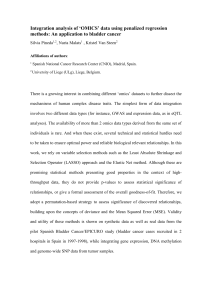
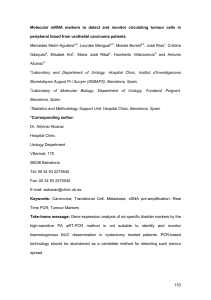
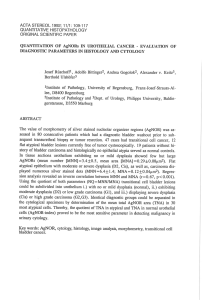
![[PDF]](http://s1.studylibfr.com/store/data/008642620_1-fb1e001169026d88c242b9b72a76c393-300x300.png)

